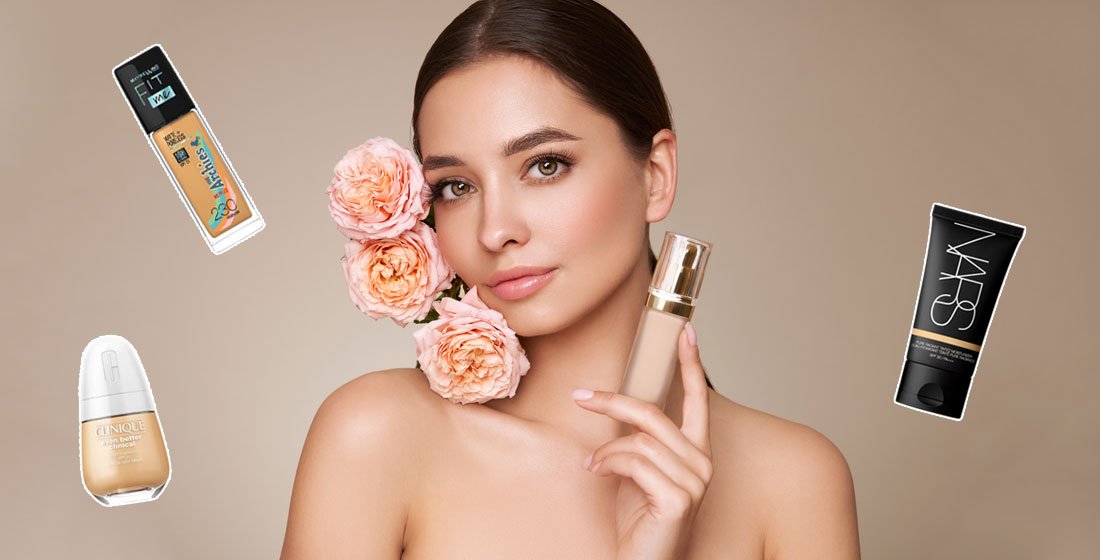Blog
How to Choose the Right Foundation for Your Skin Tone

Choosing the right foundation involves more than finding any shade—it’s about balancing skin tone, undertone, skin type, coverage preference, and increasingly, available seasonal variations. Here’s your comprehensive step-by-step guide to nail that perfect match:
1. Identify Your Skin Tone
Your skin tone is the visible surface color of your complexion and generally classified as: Fair, Light, Medium, Deep.
You can determine yours by noticing how your skin reacts to sun exposure—very fair skin tends to burn, while deeper tones tan easily. Always assess under natural daylight for the best accuracy. Getprice+13Patrick Ta Beauty+13L’Oreal Paris+13
2. Determine Your Undertone
Undertone is the subtle hue beneath your skin and doesn’t change with tanning or seasonal shifts. It falls into one of three categories:
- Cool: hints of blue, pink, or red. Look for blue/purple veins or jewelry that suits silver.
- Warm: peachy, golden, or yellow hues. Veins appear greenish, and gold jewelry is flattering.
- Neutral: a mix of both—veins appear blue-green, and both gold and silver suit you. Patrick Ta Beauty+4Jane Iredale+4L’Oreal Paris+4
Quick tests at home:
- Examine veins on the inner wrist.
- Hold white/off-white fabric next to your face: white makes you look yellowish = warm; off-white makes you rosy = cool; both suit you = neutral.
- Observe which jewelry (gold or silver) looks better.
Jane Iredale
3. Narrow by Undertone and Shade Label
Most foundations have undertone indicators: C (cool), W (warm), or N (neutral). Once you know your tone, look only at shades labeled accordingly to avoid a mismatch. Maybelline+15L’Oreal Paris+15Jane Iredale+15
4. Swatch-Test in the Right Areas
- Swatch on your jawline or upper chest (ideal if your face is unevenly tanned compared to body).
- Apply under natural daylight—move outdoors or near a window.
- Let the foundation sit for 5–10 minutes—shades can oxidize or settle differently than they look out of the bottle.
- Choose the shade that “disappears” into your skin, blending into neck and décolleté. Reddit+9L’Oreal Paris+9codeeight.com+9Teen Vogue+3codeeight.com+3nypost.com+3
5. Consider Skin Type & Coverage
| Skin Type | Finish Recommendation |
|---|---|
| Oily | Matte or oil-free foundation for shine control |
| Dry | Dewy or hydrating liquid/serum foundations |
| Combination | A hybrid or balanced formula for both oily and dry zones |
| Sensitive | Fragrance-free, dermatologist-tested, gentle ingredients |
Additionally, match your desired coverage:
- Sheer for natural, everyday wear
- Medium for polish without heaviness
- Full coverage for long-lasting concealment or evening use
Pretty Palace+1L’Oreal Paris+1L’Oreal ParisWIREDTeen Vogue+4Patrick Ta Beauty+4lauramercier.com+4Lamel Makeup
6. Adjust with Seasons & Mix Shades
Your skin tone may shift seasonally: lighter in winter, darker in summer. Keep two complementary shades on hand, or mix them to customize. This helps avoid a mismatched complexion and ensures a seamless look year-round. Patrick Ta BeautyL’Oreal Pariscodeeight.com
7. Leverage Shade-Matching Tools & Tech
- Most beauty retailers like Ulta, L’Oréal, Urban Decay, Maybelline, and Laura Mercier offer virtual foundation finders—often using AI to scan your face under natural light and recommend matching shades. Ulta BeautyUrban Decaylauramercier.com
- For precision, new at-home devices like BoldHue can scan your facials and custom-print a perfectly matched foundation for you. This advanced option delivers up to 12 hours of wear and a dewy, personalized formula. WIRED
8. Tips from Makeup Pros & Community Wisdom
- Don’t trust only hand swatches—focus on jaw, neck, or chest where color consistency matters most.
- Try multiple shades, let them settle, then view in varied lighting (natural daylight is the most reliable).
- Mix shades if you fall between two.
- If possible, get free samples (Sephora, Ulta) to wear at home before committing.
- When matched professionally, stay cautious—some matches can be mismatched, so trial at home is wise.
The Sun
✅ Quick Foundation-Find Checklis
- Determine your skin tone (Fair, Light, Medium, Deep)
- Test for undertone using veins, jewelry, or fabric comparisons
- Narrow selections to C/W/N based on your undertone
- Swatch on jawline or chest and observe in daylight after settling
- Pick formula suited to your skin type and coverage preference
- Adjust for seasonal tone changes by mixing or keeping multiple shades
- Use virtual shade finders or advanced tools like BoldHue if available
- Test at home, wearing the shade for a day before buying full-size
🛍 Recommended Foundations (Varied Ranges & Finishes)
- Makeup For Ever HD Skin Hydra Glow Foundation – great for dry or mature skin with hyaluronic acid and radiant finish. L’Oreal Paris+1Patrick Ta Beauty+1SELF+1Jane Iredale+1Patrick Ta BeautyPretty Palacenypost.com
- Charlotte Tilbury Airbrush Flawless Foundation – full coverage, weightless feel, ideal for long wear. nypost.com
- IT Cosmetics CC+ with SPF 50+ – great for sun protection and light, blended coverage. nypost.com
- Drugstore favorites:
- L’Oréal Paris Liquid Foundation – buildable, hydrating, wide shade range under $35.
- Maybelline Fit Me or Rimmel Lasting Finish – budget champions with decent coverage and shade ranges. Getprice
Final Thought
Finding the right foundation is a balance of science and experimentation. Once you’ve mastered undertones, tested shades under natural light, and selected a formula that suits your skin type and coverage needs, you’ll achieve a look that blends seamlessly and feels like your skin—only better.

